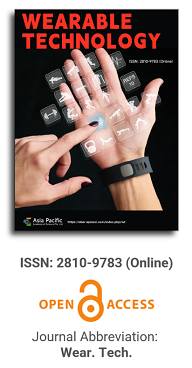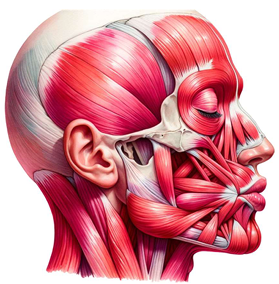

This paper delves deeply into the innovative realm of integrating human emotions with wearable technology. The primary focus is on the conceptualization and development of a kiss transfer device that harnesses the power of wearable technology to bridge the physical gap in human-human interactions. By investigating the intricate nuances of the human-human kissing process, the research seeks to replicate this intimate gesture through a technological medium. The paper not only elaborates on the anatomy, evolution, and hormonal dynamics of kissing but also underscores the transformative potential of wearable technology in capturing and transmitting these intimate moments. This exploration opens up new horizons for long-distance relationships, offering a tangible touchpoint that goes beyond traditional communication methods. Through this pioneering work, the research positions wearable technology as not just a tool for communication but as an extension of our human emotions and expressions.

Design of a multi-channel high precision wearable temperature collection system based on negative temperature coefficient thermistor
Vol 3, Issue 2, 2022
Download PDF
Abstract
Body temperature is often used to screen infectious diseases and monitor treatment. Through the method of measuring the resistance of constant voltage temperature measuring circuit, a wearable multi-point body temperature monitoring system is researched and designed to determine skin surface temperature. The STM32F103C8T6 chip is used as the core processor, and the negative temperature coefficient thermistor (NTC) as the temperature sensing component. ADS1256 chip is a temperature signal conditioner, Bluetooth module is a wireless transmission unit, and LABVIEW is used to design the host computer interface. The constant voltage bridge circuit composed of thermistor and resistor voltage divider to carry out the acquisition of 8 channels of temperature data, and the 24bits ultra-high-precision analog-to-digital conversion module is configured with differential inputs to amplify, filter and convert analog signals; the converted data is processed and calculated in the single-chip microcomputer; finally, the data is transmitted to the host computer via Bluetooth. The thermistor is linearly compensated using the fourth-order formulation of the Stein-hart formula. Reduce the impact of environmental interference and uneven body temperature distribution from software and hardware. The error during the temperature measurement of temperature sensor is analyzed. The experimental results showed that the resolution of measurement system reached 0. 01 , and the temperature measurement accuracy was up to ± 0. 02 . This design scheme has high stability and accuracy; and the circuit is simple in structure, small in size, and low power consumption which can be used in occasions requiring precise body temperature measurement.
Keywords
References
- Liu B, Tang X, Liu W, et al. Review on human core body temperature measurement method. Chinese Journal of Biomedical Engineering 2017; 36(5): 608–614.
- Xu Y, Zhang X. Based on the thermistor of digital thermometer. Electronic Test 2013; (15): 63–64, 59.
- Yuan D, Yang K, Zhang Y, et al. Design of temperature measurement system based on negative temperature coefficient. China Medical Devices 2017; 32(11): 98–103.
- Li Y. Research on technology for non-invasive human core body temperature monitoring based on single-heat-flux principle [PhD thesis]. Hangzhou: Zhejiang University, 2018.
- Tamura T, Huang M, Togawa T. Current developments in wearable thermometers. Advanced Biomedical Engineering 2018; 7: 88–99.
- Feng J, Zhou C, He C, et al. Development of an improved wearable device for core body temperature monitoring based on the dual heat flux principle. Physiological Measurement 2017; 38(4): 652.
- Atallah L, Ciuhu C, Wang C, et al. (2018). An ergonomic wearable core body temperature sensor. 2018 IEEE 15th International Conference on Wearable and Implantable Body Sensor Networks (BSN); 2018 Mar. 4–7. Las Vegas: IEEE, 70–73.
- Li Z, Gao Q, Sheng S, et al. Constant voltage topology and constant voltage output control method for wireless power transfer. Science Technology and Engineering 2020; 20(17): 6896–6901.
- Fu Q, Lu G. Multi-channel data acquisition for elevator wire Rope condition monitoring based on LabVIEW. Science Technology and Engineering 2020; 20(11): 4410–4416.
- Crawford DC, Hicks B, Thompson MJ. Which thermometer? Factors influencing best choice for intermittent clinical temperature assessment. Journal of Medical Engineering and Technology 2006; 30(4): 199–211.
- Shi L, Yang X, Wu S. A design method of NTC-thermistor temperature compensating circuit in series parallel. Journal of Fuzhou University 2003; 31(4): 417–420.
- Deng C, Hu W, Diao S, et al. Measurement error analysis and calibration technique of NTC-based body temperature sensor. Chinese Journal of Medical Instrumentation 2015; 39(6): 395–399.
- Han C, Wang Y, Zhang F, et al. Correction model of the NTC thermistors based on neural network. Electric Measurement Technology 2013; 36(9): 5–8, 22.
- General Administration of Quality Supervision Inspection and Quarantine of the People’s Republic of China, China International Standardization Administration. GB/T 21416—2008 Medical electronic thermometer. Beijing: Standards Press of China; 2008.
- Wang C, Wu Y, Yang K, et al. Design of multi-channel data acquisition system based on STM32. Application of Electronic Technique 2016; 42(1): 51–53, 57.
- Guo Y, Li Z. Design of a data acquisition device based on ADS1256 and STM32. Radio Engineering 2019; 49(1): 81–85.
- Meng F. The nonlinearity of NTC thermal resistor and compensation. Sensor World 2003; (5): 21–24.
- Wan Y. Wearable multi-point temperature system [PhD thesis]. Chengdu: Southwest Jiaotong University, 2017.
- Zhou C, Li C. Principle and application of new type 8-channel 24-Bit Δ-ΣAnalog-to-Digital Convert ADS1256. International Electronic Elements 2005; (6): 35–38.
- C8051F980 Datasheet. Silicon Lab, Austin, Texas, USA. Available from: http://www.silabs.com/Support%20Documents/TechnicalDocs/C8051F99x.
- Deng C. Research of wearable electron its thermometer and its software & hardware design [PhD thesis]. Hefei: University of Science and Technology of China, 2016.
- Ni X, Zhang L, Ren G. Design of high precision thermistor temperature measurement based on MSP430F. Instrument Technique and Sensor 2009; 183(3): 100–103.
- Zeng Q, Chen L, Xie M, et al. Calibration of thermostatic bath used on electronic thermometer verification. Applied Mechanics and Materials 2014; 635: 819–823.
- Pusnik I, Bojkovski J, Drnovsek J (2007). Development of a calibration bath for clinical thermometers. 11th Mediterranean Conference on Medical and Biomedical Engineering and Computing; 2007 Jun. 26 30. Heidelberg: Springer, 338–341.
- Wang H. Charge and discharge module for lithium battery. Electronic Technology 2017; (7): 36–38.
Supporting Agencies
Copyright (c) 2022 Jie Tao, Julaiti Maitirouzi, Huiqing Luo, Tusheng Guo, Ping Wang, Hangning Ren

This work is licensed under a Creative Commons Attribution 4.0 International License.

Prof. Zhen Cao
College of Information Science & Electronic Engineering, Zhejiang University
China, China
Processing Speed
-
-
-
- <5 days from submission to initial review decision;
- 62% acceptance rate
-
-
Asia Pacific Academy of Science Pte. Ltd. (APACSCI) specializes in international journal publishing. APACSCI adopts the open access publishing model and provides an important communication bridge for academic groups whose interest fields include engineering, technology, medicine, computer, mathematics, agriculture and forestry, and environment.





